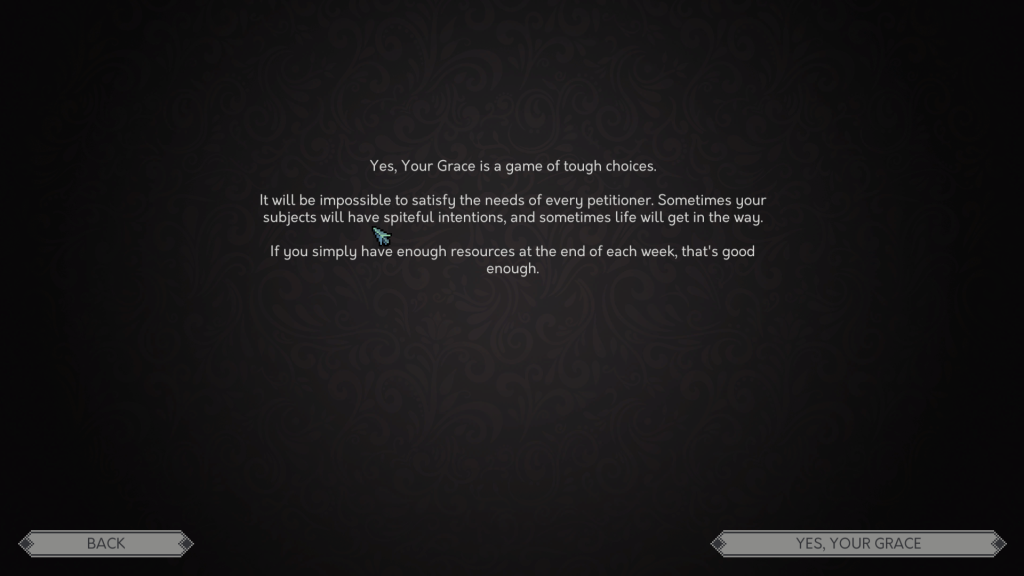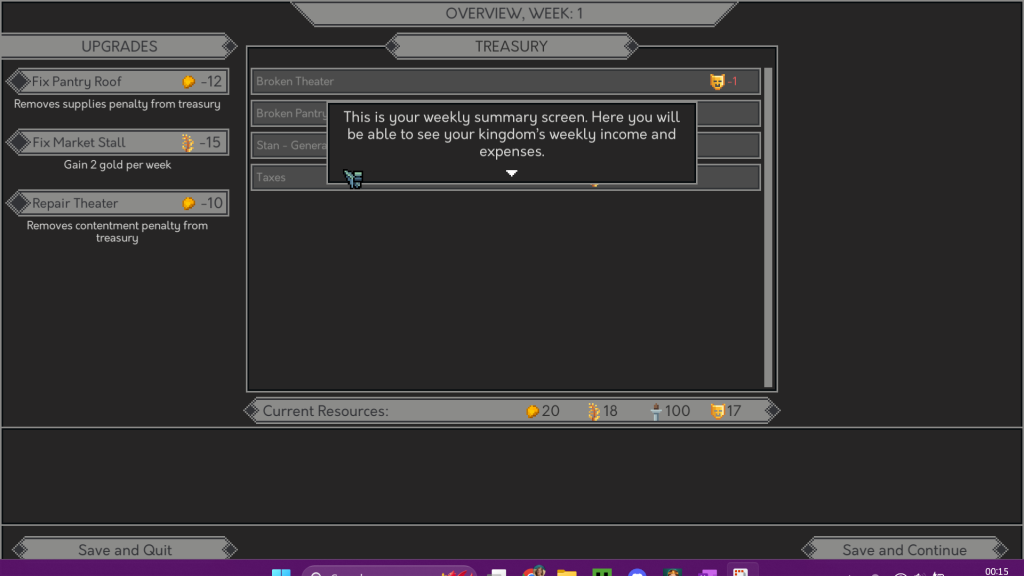As part of my research into games that share thematic, genre, or mechanical similarities with Those Left Behind, I took advantage of the Steam sale and have been analysing Yes, Your Grace, a medieval kingdom management game developed by Brave at Night. This research aims to identify successful design choices and explore how they can be adapted or reimagined for my own project.
Overview
Yes, Your Grace is a narrative-driven resource management game where players take on the role of a king making difficult decisions to sustain their kingdom. The game combines choice-driven storytelling, limited resource management, and moral dilemmas, all of which influence the survival of the player’s people and the unfolding narrative. These elements are directly relevant to Those Left Behind, which also focuses on managing resources and making impactful decisions in a post-apocalyptic setting.

Key Design Elements and Their Relevance
1. Decision-Making and Consequences
One of Yes, Your Grace’s standout features is its branching narrative, where each choice affects future events, shaping alliances and determining the fate of the kingdom. This aligns with Those Left Behind, where players must make difficult moral and survival choices that have lasting consequences for their camp.
Application to Those Left Behind:
- Like Yes, Your Grace, Those Left Behind will focus on weighty decisions where no choice is perfect.
- The game will encourage long-term thinking, as certain actions may lead to unforeseen consequences later.
- The emotional weight of choices will be emphasised through dialogue, character reactions, and world changes.
2. Resource Management Under Pressure
In Yes, Your Grace, players must balance their resources (gold, supplies, army and contentment) while addressing the needs of petitioners. The challenge comes from having too many demands and not enough resources, forcing the player to make tough decisions about who to help. The game works in weeks and every choice I make is documented, sometimes I can consult my family before I move on to the next week.
Potential Application to Those Left Behind:
- Scarcity could create moral dilemmas, such as choosing between helping a sick survivor or reinforcing defenses against bandits.

3. Character-Driven Storytelling
While Yes, Your Grace features kingdom-wide decisions, it is also deeply character-driven, with a focus on the royal family and the king’s personal struggles. The player’s attachments to NPCs make the choices feel more personal and impactful.
Application to Those Left Behind:
- The game will feature Familial NPCs that players can grow attached to, making decisions more emotionally charged.
- Dialogue and interactions will allow players to form relationships with survivors, influencing morale and trust within the camp.
- The player’s family will have their own opinions, goals, and conflicts, adding depth to decision-making.
4. Aesthetics and Presentation
Yes, Your Grace uses pixel art with a limited color palette to create a distinct visual identity. The UI is simple and functional, focusing on conveying information clearly.
Application to Those Left Behind:
- Those Left Behind will use a stylised, minimalist UI, inspired by retro futuristic devices like the Pip-Boy from Fallout, to enhance immersion.
- The presentation of choices will be designed to be clear yet atmospheric, emphasising the weight of every decision.
Conclusion and Review
I quite enjoyed playing Yes, Your Grace. It was decievingly simple at first but the constant demand and lack of resources turned the game into a strategic battle of what to prioritise. This was especially true as I tried to play a run where I wanted to make everyone happy – the family, the kingdom and allies. I was most annoyed when I would upset the family members, particularly the eldest daughter, who I HATED having to give away to get married. In a way, I saw displeasing the Kingdom as the lose condition and everything else I could sort of half think-about.
The key take away from Yes, Your Grace is their simple way of handling resources over a weekly period. The specific thing that I want to bring to the technical designer is the game’s use of a weekly summary, where after ending a week, players can see their loses and gains and mentally plan accordingly for the next week.

I let the other members of the team know to try out the game if its on sale again and they’re willing to spend a few pounds on it. It’s worth it!

Leave a Reply